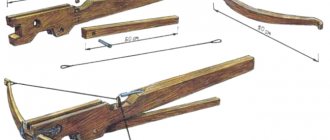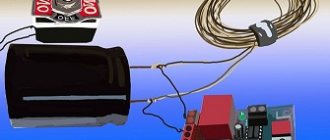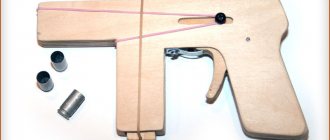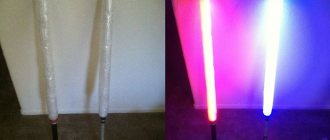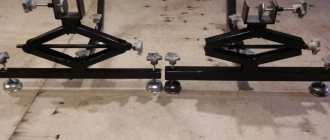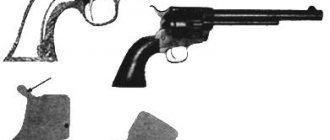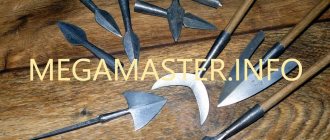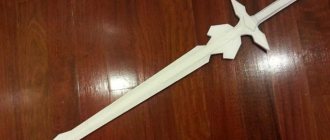The spring crossbow gets its name from the power element in its composition - without a spring it turns into a model of an ancient weapon. Any spring is suitable for it: from old ones from mattresses or spring units to products made from composites.
Spring crossbow.
Gun and crossbow: who is who?
The principle of operation is clear: the working fluid is compressed air, which pushes the harpoon out of the barrel.
Many models are equipped with a shot power regulator, which allows you to reduce it by almost half, for example, when there is a danger of damaging the harpoon on an underwater rock against which the prey is pressed. Here the harpoon is fired using the energy accumulated during the tension of elastic elements - rubber bands, analogues of crossbow arms, which are simply ineffective under water. The role of the bowstring is played by a V-shaped steel leash. It is clearly noticeable how the power is regulated on some samples: when shooting at small fish at close range, you can pull only one pair of strings, but if the situation changes, both.
And in our case, a whole series of devices where the arrow is thrown using compressed air is still not entirely correct to classify as crossbows. Let's look at an illustrative example - "Arcus Arrowstar". So:
“Arcus Arrowstar” (pictured) is produced by the Austrian arms company SEMEX GmbH, founded in 1994 and supplying, in particular, to law enforcement agencies.
The energy source is a 16-gram canister of liquefied carbon dioxide. It is possible to order an adapter for the much more familiar 12-gram one. The pressure regulator of the basic version is set to 48 bar, which allows you to fire about 20 shots with a muzzle energy of 10 joules (a 17-joule version is also available). For Germany, where there is a familiar limit of 7.5 J, the pressure is set using a special spring to 33 bar. This “F-variant” is capable of firing 40 shots at a projectile speed of about 40 meters per second.
Now about these shells themselves. The arrow weighs 9.5 grams and has a caliber of 5.9 mm. The fact is that in Austria there are no restrictions on muzzle energy for such samples, but there is a 6-mm license-free caliber threshold.
Why did we suddenly remember this not-so-new arrow launcher? Firstly, it is really quite original, nothing similar comes to mind. And secondly, our colleagues from the Kalashnikov magazine visited the IWA-2018 arms exhibition in Nuremberg and could not ignore the new product from SEMEX GmbH - the Viper large-caliber arrow launcher. The photo shows him in front of the Arcus Arrowstar.
And indeed, judging by the arrows presented here, the caliber is something like 9 mm, or even more. Alas, the manufacturer did not present any specific performance characteristics of the Viper. What is clear: if you look closely, you will notice the inscription “prototyp” on the body of the device.
PS But you haven’t seen yet another creation of the famous German inventor Jörg Sprave (more precisely, Sprave). By the way, it was from underwater guns that he created a six-barreled pneumatic crossbow - the original “Vulcan Phalanx” :)).
Update, December 2022
Drawing of block assembly parts:
Pay special attention to the processing of the arrow guides and bowstring. The clarity of their finish greatly influences shooting accuracy. The guide lines must be perfectly straight and smooth. The best choice would be grinding on a milling machine and subsequent processing with fine-grain sandpaper. Next comes polishing the guides. You can see the dimensions of the boom guide groove in the drawings. The crosspiece, with the shoulders attached to it, is installed at the end of the stock. It is usually made from an aluminum billet. Wood can also serve as a suitable material.
Pneumatic line throwers
In addition to the semi-toy samples described above, there are very serious products that perform no less serious tasks. These are, first of all, various kinds of line throwers, used, for example, when mooring ships or by rescuers (pictured is the rescue pneumatic line thrower “Filin”).
His throwing range is limited by the length of the line - 100 m, no matter vertically, horizontally or at any angle.
There are longer-range analogs, for which we are talking about hundreds of meters, for example, like the ISTA-240.
The firing technique is very similar to that of anti-tank grenade launchers.
Safety precautions
When creating a crossbow, it is necessary to adhere to safety precautions - as a guarantee of the health of yourself and those around you:
- When cutting and drilling materials, wear glasses and protect your fingers;
- before cutting the wire and driving in the bushings, make sure that there are no body parts in the path of the tool’s movement;
- fasteners - placed in a known place, and not under your feet or on a chair;
- placement of tools and materials is in order and without chaotic mixing.
All operations should be carried out without haste and with an accurate understanding of what is happening.
As for the safety precautions for handling a crossbow as a traumatic object, the following points stand out:
- before use, all parts are checked for integrity and functionality;
- when the bowstring is taut, the crossbow is already dangerous - pointing it at people is prohibited;
A crossbow is a dangerous weapon. - selection of a projectile - in accordance with the capabilities of the bowstring and the length of the stock (a straight arrow is required - not a crooked tree branch);
- before firing, make sure that there are no people or animals hidden in the projectile’s flight path;
- It is not recommended to touch the optical sight with your face due to recoil;
- the direction of the projectile's departure must be constantly monitored; turning away from a loaded crossbow is not allowed;
- shoot only in a fenced or completely safe place, without the arrow going vertically upward.
Only sober and healthy persons are allowed to use a crossbow.
Hunting pneumatic arrow throwers
Of course, gunsmiths could not ignore the pneumatic principle.
A few years ago, a slight stir was caused by information about the appearance on the market (albeit foreign) of a certain superweapon - Airrow Stealth Model 8S1P (pictured)
Either a CO2 cylinder or compressed air was used as an energy source. This example, costing under $2,000, sent a 16-inch 2512 boom (Easton XX75) at speeds of up to 600 ft/sec, or more than 180 m/sec. Such indicators are unattainable even for modern compound crossbows; 410 fps is still a kind of “ceiling” for production models.
One point was not at all clear - what to do with the plumage? For devices operating over short distances, it is not necessary, and under water it completely interferes. But for the stated speeds of Airrow Stealth, the distances must be hundreds of meters. It was suggested that some cunning modifications of arrows were used here, which, like cruise missiles, opened the tail after leaving the barrel. As it turned out, the trunk was precisely the solution - it was no coincidence that manufacturers asked such sums for their products, since the design turned out to be very complex.
The same can be said about the new product on the market - the Pioneer Airbow arrow thrower from the famous manufacturer of air rifles and pistols, also produced under the Benjamin brand.
This is a very real hunting machine, delivering a solid 450 fps, or almost 140 m/s, with a hunting arrow weighing 375 grains. These indicators are quite enough for this:
Moreover, the domestic armory (formerly Luftmaster), known for its Lesnik PCP rifles and the ultra-compact Anchutka, a new product on the market, began accepting orders for the Kashchei pneumatic arrow gun .
It is based on the same technical solutions as the Pioneer, only the price is completely different for obvious reasons. By the way, “Kashchey”, in order not to conflict with weapons legislation, is certified as a “device for installation, rescue and reconnaissance work in hard-to-reach places.” Well, that's not a bad idea. I know the developer a little, I saw test shootings - it’s impressive.
By the way, since August 2016, even ordinary serial PCP rifles can also be used to throw heavy hunting crossbow bolts (see “Air Arrows”).
Block
The block is the second most important component of a crossbow after the lock. This element plays a connecting role between the shoulders and the rest of the crossbow structure. It is the block that bears the entire load of the arcs in their pure form. It is the block that must withstand enormous loads during a shot. It is on the block that all the energy of the so-called “reverse recoil” occurs, when the arrow has already flown out, and the shoulders continue to straighten further at enormous speed. That's why so much attention is paid to the block. Typically, high-strength steel is used for the block; on expensive crossbows, titanium is used. Although I sometimes met crazy would-be designers who put an aluminum profile block on their 80-kilogram crossbows. And then they wondered why, after a dozen shots, she was turning inside out.
Source
Unusual crossbows and bows
This role can also be played by rubber, like in underwater crossbows, or a spring. But the latter can be either ordinary twisted or gas, that is, pneumatic.
Spring block "Cobra"
And such devices really exist. I already mentioned one of them in the article about the vertical crossbow. This is an ultra-compact spring-block bow “Cobra” based on high-pressure gas springs.
The author is the famous designer of mechanical bows Bogdan. It took him many years to get to “Cobra”, there were also “Phantom”, “Rustle”, and only God knows the number of intermediate options. The speed characteristics of the product reach 85 m/s with a maximum tension force, which can be adjusted from 22 to 27 kgf. For such a tiny thing, this is very, very good.
Bogdan also had a spring-lever bow “Piranha” (not a blocker), and a mechanical bow “Shadow”, where rubber bands were used as elastic elements (pictured).
Making a bowstring
First of all, you need to make a special machine for weaving this part: take a rope and measure the length of the bowstring. After this, saw off a board with dimensions slightly larger than this parameter. Next, mark the length of the string on the board and drill two holes in these places - this is where you need to insert your nails.
Take the thread, tie it to one of the nails, and leave a margin equal to the length of the bowstring. After this, begin to evenly wrap the threads around the nails (Dacron is best). Continue this process until the base of the bowstring reaches 5mm. To do this you will need to make 5-6 full turns. Try to keep the threads equally tight.
Next, wrap the base near the nails on both sides several times with wrapping material. This will create loops at the ends. You can understand how to do this from the above diagram. Do not forget to wrap the middle of the bowstring, because this part suffers greatly from friction. Tie the cut ends of the threads with a sailor's knot and lubricate them thoroughly with glue so that the entire structure is strong. After which you can pull the bowstring onto the arc and adjust the degree of its tension.
Crossbow arrow tips
The simplest and most convenient way to make high-quality tips is very original! If possible, you need to pick up spent 7.62 caliber bullets at military training grounds where Kalashnikov assault rifles are fired. The steel core in the bullet is secured with a lead plug at the bottom. Those. If you heat a bullet (you can even do this over a fire in a tin can) so that the lead melts, the steel core will fall out of it. Here you have a finished, neat tip with a tip specially designed for shooting. And besides, due to the deep hole formed after removing the core, this tip is very easily attached to the arrow itself. It simply fits onto the sharpened end like a cap.
If there is a need to strengthen the arrow (depending on the length), then we place the bullet casing on a cut rod, a nail or screw of a suitable diameter and screw it into the end of the arrow, with a pre-drilled hole, of course, - names, but this is how the arrowheads of factory crossbows are attached
Approximate parameters of arrows for crossbows:
- Length: 120 – 170 mm;
- Diameter: 7 - 8 mm;
- Number of feathers: 3 or 4 pcs.;
- Feather length: 30 - 50 mm;
- Feather height: 5 - 8 mm;
- Arrow weight: 10 - 40 g.
The center of gravity of the crossbow arrow should be located at a distance of 1/3 from the tip.


